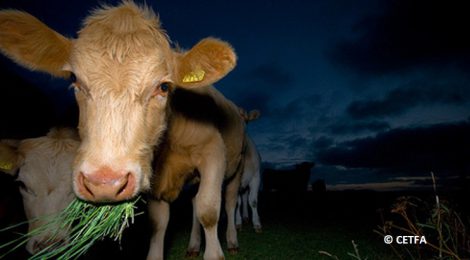
Where does violence start?
The suspect in the recent brutal murder of a young man from whom one foot was sent to the Tory HQ in Ottawa is alleged to have previously tortured kittens before committing his latest crime. The relation between abuse inflicted on animals and abuse inflicted on humans has been well documented by psychologists, sociologists and criminologists during the past decades: what begins at deliberate violence against weak, vulnerable animals often escalates to violence against humans.
But what happens when violence to animals is inflicted on a regular basis as part of a daily job, such as in the case of workers in the animal agriculture industry? Can the violence have psychological or emotional repercussions that deeply impact the well-being of the workers, and of society as a whole?
To attempt to answer this question, we interview Dr. Amy J. Fitzgerald, Associate Professor in the Department of Sociology, Anthropology & Criminology at the University of Windsor, to learn more about her research on slaughterhouses and crime.
Dr. Berreville / CETFA: In your paper entitled: “Slaughterhouses and Increased Crime Rates: An Empirical Analysis of Spillover from The Jungle into the Surrounding Community“, you compile and analyze a large number of statistical data to examine the link between violence and increased crimes in communities and the presence of a slaughterhouse. What inspired you to do this kind of research?
Dr. Amy Fitzgerald: My interest in this area was stimulated in the midst of reading academic articles on slaughterhouse communities which mentioned that crime rates increased in communities where large new slaughterhouses were sited. The authors of these articles speculated about some of the possible reasons for these increases, but the unique nature of work inside slaughterhouses was not mentioned as a possible factor. I therefore became interested in examining whether there was a connection between crime rates and slaughterhouses more generally, or if it only existed in communities with large new slaughterhouses, and whether the factors hypothesized as being responsible for the crime increases (population density, unemployment levels, the demographic makeup of the community, etc.) could in fact explain this relationship.
Dr. Berreville / CETFA: What are the most compelling findings of your research?
Dr. Amy Fitzgerald: I think the two most compelling findings are that (1) when we statistically controlled for several common correlates of crime in communities, there was still a significant relationship between slaughterhouse employment levels and violent crimes (rape in particular); (2) when we compared slaughterhouse employment levels with employment levels in other similar industries (similar in that they include routinized labour, rely heavily on immigrant workers, and have high rates of injuries and illnesses) it was clear that slaughterhouses were unique in their relationship with the crime rates; in fact, many of the comparison industries had the opposite relationship with crime rates.
Dr. Berreville / CETFA: In your paper, you suggest that slaughterhouses are a unique environment for workers because they deal with living, sentient beings, and that the violence imparted on these beings might lead to desensitization. How could desensitization to the suffering of animals lead people to commit violent crimes towards other human beings, including their own family?
Dr. Amy Fitzgerald: Our study demonstrates that there is something unique about the relationship between slaughterhouse employment levels and crime rates. There is now a great need for further research to examine exactly why this relationship exists.
Dr. Berreville / CETFA: Do you think that this desensitization process is amplified in large slaughterhouses where production demands lead to many animals not being stunned properly and being stabbed, suspended and dismembered while still alive?
Dr. Amy Fitzgerald: If there is a desensitization process involved here then I would expect that it could be exacerbated by having to dismember animals that are clearly conscious.
Dr. Berreville / CETFA: In a Windsor Star article featuring your study, Neil Weston, owner of a Windsor pig slaughterhouse, states that the meat industry currently struggles and that ‘studies that link the business to something negative, no matter how loosely, is simply unfair’. What do you respond to this kind of criticism?
Dr. Amy Fitzgerald: I understand that the meat industry would not be pleased with the findings of our study. However, I disagree that communicating research results that may be unfavourable to the industry is unfair. I think what would be unfair would be to put all of the onus of any negative consequences of the industry on the producers; consumers (and regulators in some cases) bear some responsibility as well.
Dr. Berreville / CETFA: Following the release of the 1906 novel The Jungle, which examined the workers poor conditions and exploitation in slaughterhouses, President Theodore Roosevelt reformed the meat industry, resulting in improvements for the workers. What would you hope the publication of your study would result in?
Dr. Amy Fitzgerald: I hope that this study results in further research so that we may better understand the relationship between slaughterhouses employment levels and crime rates. I would also hope that it stimulates more critical thinking about the currents ways in which industrial animal agriculture and slaughter produces meat.
For more information:
References:
Sara C. Haden and Angela Scarpa, “Childhood Animal Cruelty: A Review of Research, Assessment, and Therapeutic Issues,” The Forensic Examiner 14 (2005): 23-33.
Fitzgerald, Amy J.; Kalof, Linda; Dietz, Thomas, Slaughterhouses and Increased Crime Rates: An Empirical Analysis of Spillover from ‘The Jungle” into the Surrounding Community, Organization and Environment, 22, 158-184, 2009.
Dr. Fitzgerald`s website:
http://amyfitzgerald.wordpress.com


